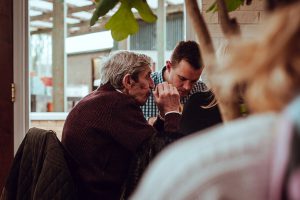Depression is common in older adults.

Late-life depression affects 6 million Americans aged 65 or older yet only 10% receive treatment. Even though older adults are at an increased risk for experiencing depression, it is not a normal part of aging.
Factors that affect mental health change across the lifespan. Aging presents significant and unique life transitions. For some older adults, health problems, loss of driving privileges, reduced feelings of vitality or purpose, or the loss of loved ones may trigger sadness. And today, it may be COVID-19 related. Sometimes sadness lasts longer than it should. How does sadness differ from depression?
Sadness happens when we’re confronted with loss, a disappointing event, experience, or situation that renders us hurt or challenged. When we’re sad we feel sad about that something. As time passes we adjust and our sorrow falls off, then falls away.
Depression differs from sadness.
Sometimes depression is caused by the aforementioned factors, but sometimes not. Depression differs from sadness because it sticks around. Depression is constant and ever-present and makes us feel sad about everything.
Grief differs from sadness and depression in that sorrow and pleasure may change places or even co-exist. Simply stated, grieving is a roller-coaster. No two people grieve alike; however, persistent grief might mean depression.
Spotting depression is not always easy.
Spotting depression is not always easy. Oftentimes it goes unnoticed due to lessened connection and diminishing human interaction. Retirement, declining health, relocations, financial concerns and such are impetuses for shrinking social circles. Without these paths for connection, feelings of loneliness and isolation can take hold. Maybe fewer people are around to be on the lookout for signs of depression? Chicken and egg?

Depression in older adults is frequently confused with the effects of multiple illnesses and the medicines used to treat them. It might be more challenging to identify depression in older adults because they might not even report feeling sad. Instead, they may complain of constant fatigue or achiness. According to the National Center for Aging, these common symptoms lasting more than two weeks may indicate depression:
- Persistent sad, anxious, or “empty” mood
- Feelings of hopelessness, guilt, worthlessness, or helplessness
- Irritability, restlessness, or having trouble sitting still
- Loss of interest in once pleasurable activities, including sex
- Decreased energy or fatigue
- Moving or talking more slowly
- Difficulty remembering, concentrating, making decisions
- Difficulty sleeping, early-morning awakening, or oversleeping
- Eating more or less than usual, usually with unplanned weight gain or loss
- Thoughts of death or suicide, or suicide attempts
- Aches or pains, headaches, cramps, or digestive problems without a clear physical cause and/or that do not ease with treatment
- Frequent crying
How can you help when “nothing’s the matter”?
What if your loved one is in denial, avoids talking about it, or refuses help? How can you help in these trying times? Reach out and stay connected, tell and show them they are loved. Suggestions include monitoring medications, tracking their sleep and eating patterns, promoting a sense of purpose, facilitating virtual connection. The key is to reach out and reach out often. If they live afar, consider requesting law enforcement to do frequent well-checks and phone daily. Even if this feels unnatural, do it anyway. These are unprecedented times that require extraordinary action. You may even want to introduce them to the benefits of professional help. During this time of physical distancing and quarantines, their physician may be able to recommend a counselor who uses a reputable application for Telepsychology. Even though it may not be as good as face-to-face, it’s a start.
Most especially and above all, try to get this message across: Depression is not a sign of a person’s weakness or a character flaw. People don’t snap out of depression without treatment and treatment varies widely among sufferers. In most cases depression is treatable in older adults. Risk taking the first step to help. If not now, then when? You will not regret it.
To learn more read the fact sheet developed by National Alliance on Mental Illness (NAMI) https://d2mkcg26uvg1cz.cloudfront.net/wp-content/uploads/Depression_Older_Persons_FactSheet_2009.pdf
 0
0
